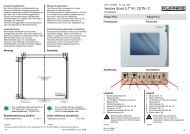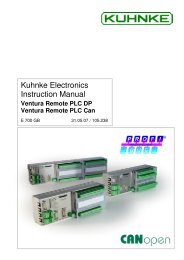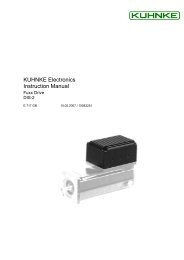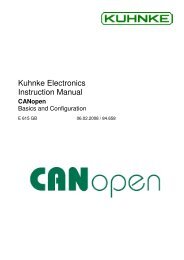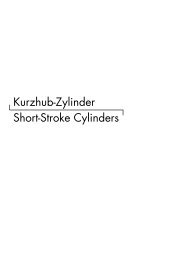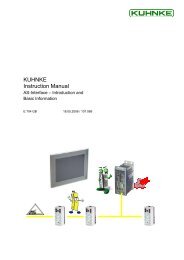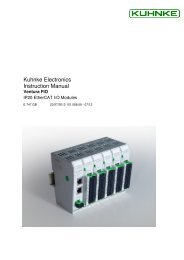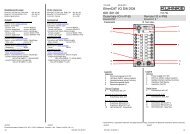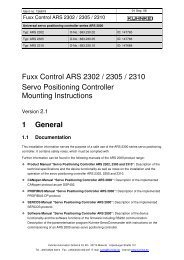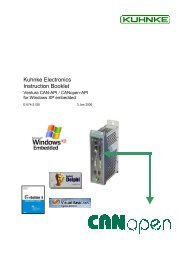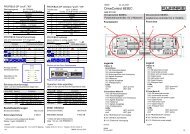Fuxx Control - ARS 2320 / ARS 2340 Instruction Manual - Kuhnke
Fuxx Control - ARS 2320 / ARS 2340 Instruction Manual - Kuhnke
Fuxx Control - ARS 2320 / ARS 2340 Instruction Manual - Kuhnke
You also want an ePaper? Increase the reach of your titles
YUMPU automatically turns print PDFs into web optimized ePapers that Google loves.
<strong>Fuxx</strong> <strong>Control</strong> <strong>ARS</strong> <strong>2320</strong> / <strong>ARS</strong> <strong>2340</strong> KUHNKE Automation<br />
8.7.4 Cable type and configuration [X1]<br />
The cable names given refer to cables made by Lapp. They have proven to be reliable and are<br />
successfully used in many applications. However, it is also possible to use comparable cables from<br />
other manufacturers, e.g. Lütze or Helukabel.<br />
� LAPP KABEL UNITRONIC-LiYCY; 25 x 0.25 mm²<br />
Figure 24 shows the cable between the <strong>ARS</strong> 2300 servo positioning controller and the control system.<br />
The cable shown has two cable shields.<br />
The outer cable shield is connected to PE on both sides. Inside the <strong>ARS</strong> 2300 servo positioning<br />
controller, the connector housing of the D-Sub connector is connected to PE. If metal D-Sub<br />
connector housings are used, the cable shield is simply squeezed underneath the strain relief.<br />
Often an unshielded cable is sufficient for 24V signals. In environments with high interferences or in<br />
the case of long cables (l > 2m) between the control system and the <strong>ARS</strong> 2300 servo positioning<br />
controller, <strong>Kuhnke</strong> recommends using shielded control cables.<br />
Although the analog inputs of the <strong>ARS</strong> 2300 servo positioning controller are differential, using<br />
unshielded cables for the analog signals is not recommended as interferences, e.g. caused by<br />
switching contacts, or output stage interferences of the converters can reach high amplitudes. They<br />
couple themselves into the analog signals and cause common-mode interferences which may lead to<br />
deviations of the analog measured values.<br />
In the case of limited cable lengths (l < 2m, wiring inside the control cabinet), the outer dual-sided PE<br />
shield is enough to guarantee trouble-free operation.<br />
For optimal interference suppression of the analog signals, the cores for the analog signals have to be<br />
shielded together and separated from other cores. At the <strong>ARS</strong> 2300 servo positioning controller, the<br />
inner cable shield is connected on one side to AGND (pin 1 or 14). It can be connected on both sides<br />
in order to establish a connection between the reference potentials of the control system and the <strong>ARS</strong><br />
2300 servo positioning controller. Pins 1 and 14 are directly connected to each other inside the<br />
controller.<br />
8.7.5 Connection notes [X1]<br />
The digital inputs are rated for control voltages of 24V. The high signal level already ensures a high<br />
level of interference immunity of these inputs. The <strong>ARS</strong> 2300 servo positioning controller provides an<br />
auxiliary voltage of 24V which may be loaded with 100 mA maximum. As a result, the inputs can be<br />
activated directly via switches. Activation via the 24V outputs of a PLC is of course also possible.<br />
The digital outputs are so-called "high-side switches". This means that the 24V of the <strong>ARS</strong> 2300 servo<br />
positioning controller are actively switched through to the output. Loads such as lamps, relays, etc. are<br />
thus switched from the output to GND24. The four outputs DOUT0 to DOUT3 can be loaded with a<br />
maximum of 100mA each. The outputs can also be led directly to 24V inputs of a PLC.<br />
94 E 732 GB<br />
14.12.2006



